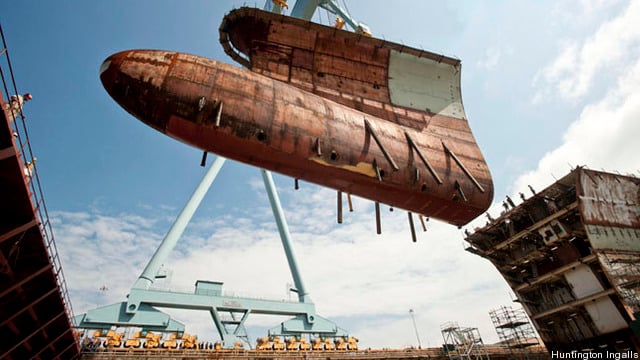
The bow of the supercarrier USS Ford is lowered into place at Newport News shipyard.
SEA AIR SPACE: After months of quietly backing away from its goal of a 355-ship fleet, the Navy finally ran into some congressional opposition today. Then, just hours after the House seapower chairman told the Navy to stop making his job harder, the undersecretary of the Navy said the 355 goal probably couldn’t be reached until 2052.

Thomas Modly
The irony is that last fall, the acting undersecretary of the Navy, a career civil servant named Thomas Dee, got publicly and unceremoniously rebuked by his boss, Secretary Richard Spencer, for suggesting that it could take the Navy until the 2050s to build a 355 ship fleet. But today, the Trump administration’s permanent appointee for the Navy’s No. 2 civilian job, Thomas Modly, told the Sea Air Space conference here that the date is 2052, given current spending projections and industrial capacity.
Modly’s comments come at a time when the Navy appears to be backing away from the 355 ship goal, revising its 30-year plan down to 342 ships by 2039. Even that plan, Modly told a lunch time crowd, “is constrained by topline funding” and an already stained industrial capacity. With the help of industry, however, “an acceleration of this plan to achieve this number sooner is certainly possible, but it will require a much more aggressive funding approach” above what has been offered by the White House, he said.
The Navy is clearly worried about the ability of a handful of shipyards to handle the work that it wants to send their way in the coming years. “We’re not going to get to 355 ships without the help of the industrial base,” said Adm. Thomas Moore, commander of Naval Sea Systems Command, during a panel discussion at the conference on Tuesday. Moore and other Navy officials said that the fault lies with the uneven budgets of recent years, and the uncertainty of the shipbuilding bottom line, year to year.
“We have seen boom and bust over the years,” said Allison Stiller from the office of Navy Research, Development and Acquisition. “And we understand that stability is absolutely vital.”
Adm. William Merz, the Navy’s deputy chief for warfare systems, also took a cautious approach when sketching out a vision for the future this week. “We caution everybody that 355 is a target,” told the conference. It’s much more important “to focus on the sum of the parts,” he added, suggesting that getting the most capable ships and aircraft — both new construction and upgrades — is more important than the number of hulls in the water.

Richard V. Spencer
But Modly’s 2052 timeline stands out, especially considering the public dressing down that his predecessor, Dee, received in October for suggesting a “mid-century” goal for hitting 355 hulls. Even with more funding, Dee claimed, “we don’t know if it’s realistic.”
His comments drew a swift response form his boss, Navy Secretary Richard Spencer, who took to the Hugh Hewitt show on MSNBC to complain. “Mr. Dee, unfortunately, being an acting placeholder, I don’t know whether he was speaking for his own accord, but this is one more reason we need to get our politically-appointed people in the Pentagon and working for us. I need to get my team there who are aligned with our vision,” Spencer said.
But if you listen closely to Spencer’s own statements during his confirmation hearing last July, he too was soft-pedaling the 355 figure. As we wrote at the time:
While “it is a great goal to have” and “a good number for people to focus on,” Spencer told the Senate Armed Services Committee, he also described the number in conditional terms such as “if in fact we grow to a 355-ship Navy…” and “whether it’s a 355-ship (fleet) or not….” He even said, albeit in tortured language, that the US might achieve the power envisioned for a 355-ship fleet with fewer but more advanced vessels: “Whether it’s a 355-ship (fleet) or not, what we also ought to get our head around is, can we have a capacity number but have a capability that’s even greater than that?” Spencer said. “(I.e.) have the capability of a 355 (ship fleet) that might be a 300-ship Navy.”

Rep. Todd Wittman
Wittman Says Whoa
So Modly’s statement is the latest in a long line of high-level equivocations of the 355 figure — and at least one key Congressman is getting sick of it.
“I think if you get ambivalent about the number, it becomes difficult to communicate” to the public, Rep. Rob Wittman, R-Va., chair of the House Armed Services Seapower and Projection Forces Subcommittee told a breakfast meeting here Wednesday. “You have to say 355 is the number.”
Wittman said that being squishy about the 355 ship fleet makes his job of pushing through higher shipbuilding budgets more difficult, because it gives critics ammunition. “This wasn’t just a number that was pulled out of the air, this was an objectively reached number (from an official Force Structure Assessment), and we think that ought to be the central part of the discussion,” Wittman said. The Congressman has said he wants the 2019 shipbuilding budget to reach $26 billion, up form the $23 billion in the fiscal 2018 bill.

DARPA’s experimental unmanned scout ship, the ACTUV Sea Hunter.
In the end, Modly said, “the right number is probably something like 355-plus” — but not all of those ships may be manned. The Navy is going to have to budget not only for more ships and thousands of additional sailors to operate them, but also fleets of air and undersea drones that can network with those ships to give them greater range of vision when confronting peer adversaries who are also investing in long-range systems.
“A larger force is necessary,” he said, but just as important as size is the ability of those ships to communicate with allies, and be able to quickly adopt new software and weapons systems as they come online in the the coming years. “A larger, more agile force will be the key to success of our maritime strategy. How we measure that ‘plus’ is far more important than how we end up counting the number of ships that make up the 355 mix.”
Sydney Freedberg also contributed to this article.






















